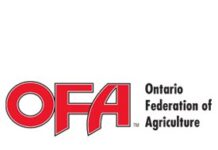by Mark Reusser, Director, OFA
Fertilizer is one of the most important tools on the farm, providing crops with the nutrients they need to grow but can’t get from the soil alone.
It’s also an expensive resource that requires careful management to ensure nutrients are available to crops when needed, and not lost to the environment.
Farmers are doing their best to manage nutrients effectively to limit emissions from fertilizer that can be lost to the atmosphere in the form of greenhouse gases that can impact the environment. Nutrient losses can also have a negative impact on water quality and aquatic species.
That’s why it’s important that nutrients on the farm, whether fertilizer or livestock manure, are managed sustainably – and this is a responsibility that farmers take seriously.
My family and I farm in Waterloo Region where we grow crops, and we follow the principles of an initiative called 4R Nutrient Stewardship.
It lets us improve the economics of farming, crop productivity and fertilizer efficiency while also benefitting the environment by ensuring we use the Right Source of fertilizer at the Right Rate applied at the Right Time and in the Right Place.
This is a formula that many farmers have long followed already; after all, using too much fertilizer or applying it in a way that wastes the nutrients instead of making them available to the crops to use just doesn’t make sense. Participating in the program means we’re not just following sustainable practices but can also prove what we’re doing.
One of the most important 4R Best Management Practices for farmers is testing their soil at least once every four years, and using those results to develop farm or even field-specific recommendations for nutrient use so we’re only giving the crop what it actually needs.
Other activities include working fertilizer into the soil as soon as possible after application to minimize losses, not applying nutrients on frozen or snow-covered ground, respecting minimum setbacks to protect environmentally sensitive areas, keeping detailed records, and more.
Losses also cost farmers money, as nutrients lost are not available for crop growth. 4R is also known as ‘nutrient use efficiency’, as it allows farmers to use a suite of best management practices to ensure nutrients are applied at a time and place and in a form and at a rate that can be best used by crops. This also minimizes losses to the environment and economic losses to the farmer.
Nationally, 4R is coordinated by Fertilizer Canada. Here in Ontario, it is agricultural retailers – businesses who sell seed and fertilizer and provide agronomic services to farmers like soil sampling or crop growing advice – who achieve a 4R certification and deliver the program to farmers.
I also serve as a board member of the Ontario Federation of Agriculture, and one of my roles is to represent farmers on the provincial 4R Steering Committee.
Through this committee, OFA works with other farm and commodity organizations and the Ontario Ministry of Agriculture, Food and Agribusiness to enhance and expand the certification program, develop resources for farmers and agricultural retailers, work on the Fertilizer Use Survey for Ontario, and raise awareness of the benefits of 4R nutrient stewardship in the agricultural community.
I’m proud of the progress that’s being made to advance sustainable practices – approximately one million acres of cropland in Ontario are currently 4R certified.
Many other farmers are using those practices even without certification. According to the 2023 Fertilizer Use Survey results, for example, more than two thirds of Ontario corn growers are following basic 4R principles on their farms – an increase of 3.5 per cent from 2020.
There is more work to be done, however, to encourage and support more of Ontario’s agricultural retailers to become 4R certified so they can offer the program to their customers, and that more farmers are aware of its benefits and principles.
Our Steering Committee is working on activities like reviewing and updating audit standards, reducing the record-keeping burden of the program for retailers, and completing an economic analysis of 4R practices.
As farmers, we have a responsibility to future generations to farm sustainably, minimize climate impacts, and look after our air, soil, and water. At the same time, we must ensure our farms remain profitable and productive, and 4R Nutrient Stewardship is an approach that lets us do that.

